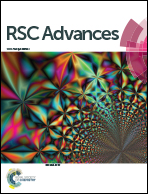Excited-state dynamics and electron transfer process of 1,3,5-triamino-2,4,6-trinitrobenzene†
Abstract
Insights into the excited-state dynamics and electron transfer processes of nitro explosives offer an efficient tool for unravelling ultrafast and complex detonation physics. In this work, the excited state dynamics and electron transfer processes of 1,3,5-triamino-2,4,6-trinitrobenzene (TATB) were studied using femtosecond transient absorption spectroscopy and time-dependent density functional theory. The de-excitation of TATB after excitation at 400 nm involves an equilibrium between the vibrationally hot S1 (S*1) and S1 states, with lifetimes of 0.64 and 6 ps, respectively. After vertical excitation, the electron density is transferred from the C-ring and NH2 group to NO2 groups. The excitation energy activates the nitro groups, and energy is redistributed via their nuclear motion. The relaxation of the initial S*1 state shows an apparent structural change occurring at one activated nitro group, which becomes further twisted from the planar benzene ring and relaxes to the S1–T1 conical intersection. The T1 state is populated via the minimal intersystem crossing through the S1–T1 intersection. The nitro group charge transfer process is then explored following the ultrafast structural change. This study advances our understanding of photo-initiated reactions as well as the ignition of energetic materials.


 Please wait while we load your content...
Please wait while we load your content...